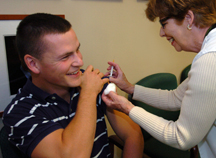
| RELATED INFO |
| * Purdue School of Veterinary Medicine |
| * Indiana State Department of Health |
| * World Rabies Day |

August 29, 2007
Purdue to make education a priority for World Rabies Day
WEST LAFAYETTE, Ind. - |
"Rabies is a zoonotic disease, which means it spreads from domestic and wild animals to people, so it's critical that people recognize signs and know how to protect themselves," said Larry Glickman, a professor of epidemiology. "The virus is in the saliva of biting animals and is usually inoculated into people through a bite wound. It may then spread to the brain over a period of weeks to months. Clinical signs usually occur when the virus enters the brain."
Symptoms in humans include increased pain at the site of the bite and/or irregular spasms of muscles when exposed to water (hydrophobia). Neurological signs, such as acting nervous, confused and upset, indicate the disease has progressed. These signs normally are visible within 30 days but, in some instances, it has been reported to occur as much as seven years after the bite.
In the United States, wild animals such as bats, raccoons and skunks are the primary reservoir of rabies. However, rabies in wild animals can spill over into unvaccinated cats, dogs and humans. The Humane Society of the United States statistics indicate that 90 percent of all reported rabies cases occur in wildlife, such as raccoons, skunks, bats and coyotes. Often the virus gets transmitted to humans when unvaccinated pets are infected by contact with wild animals and then bite humans, Glickman said.
"The best way to prevent rabies is to vaccinate pets," Glickman said. "It not only protects the pet, but it also protects people because it provides a barrier between owners and any possible contact their pet might have had with diseased wildlife."
Founded by the Centers for Disease Control and Prevention and the British charity group Alliance for Rabies Control, World Rabies Day is designed to address rabies prevention and control.
"Until now, there has not been a coordinated effort to let the world know that this disease can be readily prevented through education, pet vaccination and increased human awareness about proper wound management and administration of rabies vaccination after an exposure has occurred," said Deborah Briggs, executive director for the Alliance for Rabies Control.
An estimated 55,000 people die worldwide from rabies each year - approximately one person every 10 minutes. In the United States, dogs and cats began being regularly vaccinated between 1955 and1960, which delivered a striking blow to rabies rates. But that doesn't mean rabies has been eliminated. Each year in the United States, about four people contract rabies, with most cases resulting from a bat bite.
The type of animals that carry rabies varies across geographic areas. Raccoons are the most common carriers of rabies found on the East Coast, where state health agencies have had some success at protecting people by dropping the vaccine in ketchup-sized packets to be eaten by the raccoons. In the Midwest, skunks and bats top the list of carriers, and in Texas, skunks and coyotes are the biggest carriers.
"We've been successful at vaccinating cats and dogs, and yet Indiana still has about a dozen cases of rabies each year in animals, usually bats," said George Moore, an associate professor of epidemiology. "But the disease in domestic animals is 100 percent preventable, and prevention starts with the animal owner through the vaccination of their pet and by avoiding contact with wild animals."
It's not always easy to monitor a pet's interaction with wild animals, however. Bats, in particular, have small teeth that may leave marks that are not easily seen.
"If someone finds a bat in their home, they often do not think of the possibility of that bat being rabid," Glickman said. "However, bat bites are often so small that people, especially children, don't know they've been bitten. When human exposure to bats may have occurred, the bat should be captured and tested for rabies while avoiding any additional exposure."
Not all bats are rabid, and they serve an important role in the ecosystem by eating insects and other pests. If a bat is found in the home, the Indiana Animal Disease Diagnostic Laboratory at Purdue's School of Veterinary Medicine can test it for rabies. However, if the bat bit someone, it should be taken to the state health laboratory in Indianapolis.
"We train our future veterinarians at Purdue University to recognize signs of rabies in animals and to encourage dog and cat owners to vaccinate their pets for rabies," Glickman said. "We also vaccinate our students for rabies during the first semester of their first year at Purdue because they may come into contact with rabid animals in the clinics.
"Rabies must always be considered when encountering any animal with signs of neurological disease or paralysis. We must monitor the movement of rabies in wild animals because it often spills over into other species."
Writer: Maggie Morris, (765) 494-2432, maggiemorris@purdue.edu
Sources: George Moore, (765) 496-3393, gemoore@purdue.edu
Larry Glickman, (765) 494-6301, ltg@purdue.edu
James Howell, veterinary epidemiologist, Indiana State Department of Health, (317) 233-7272
Purdue News Service: (765) 494-2096; purduenews@purdue.edu
PHOTO CAPTION:
First-year veterinary student D.J. Weimer from Knightstown, Ind. receives a rabies vaccination from Patty Christopher, staff nurse for Purdue Student Health Center. All first-year students in the School of Veterinary Medicine are required to get the series of three rabies vaccinations during their first semester at Purdue University. (Purdue News Service photo/David Umberger)To the News Service home page
If you have trouble accessing this page because of a disability, please contact Purdue News Service at purduenews@purdue.edu.
